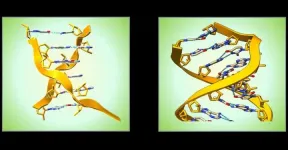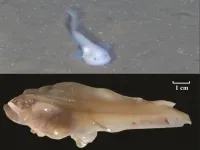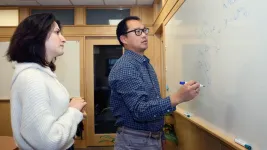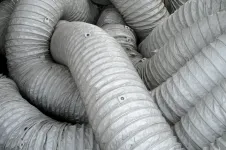A Z-RNA nanoswitch encoded by "junk DNA" turns-off immune responses against self
Left-hand RNA and self-recognition
2021-05-13
(Press-News.org) In a paper published in the May 13th, 2021 issue of PLOS Genetics, a Z-RNA nanoswitch that regulates interferon immune responses is described. The switch, less than 5 nanometer in length, is based on sequences, called flipons, that change outcomes by altering their three dimensional conformation. The Z-RNA nanoswitch flips from the shorter right-handed A-RNA helix ("on") to the longer left-handed Z-RNA helix ("off"). The flip ends immune responses against self RNAs, but not against viruses. Surprisingly, the Z-RNA nanoswitch sequence is encoded by "junk DNA". The Z-RNA nanoswitch is used by some cancers to silence anti-tumor immune responses. In other cases, a malfunction of the Z-RNA nanoswitch causes inflammatory disease.
In the paper, Dr. Alan Herbert of InsideOutBio describes how nature uses a nanoscale-Z-RNA switch to turn-off immune responses against self. The nanoswitch utilizes sequence elements called flipons that are capable of changing their three dimensional conformation under physiological conditions. The "on" state of the switch is represented by the right-handed A-form double-stranded RNA helix (dsRNA), while formation of the left-handed Z-RNA double helix turns the switch to the "off" position. The switch is used to defend against viruses that produce dsRNA when they infect cells. When the switch is "on", it starts an immune response against the virus. However, in normal cells, the nanoswitch is set to "off" as only self dsRNA is present. When the switch malfunctions and fails to turn off, Inflammatory diseases like Aicardi-Goutieres disease result. These diseases are characterized by the over-production of type I interferons. Although rare, these diseases are considered by some to provide insight into more common inflammatory diseases like systemic lupus erythematosus. Others believe that the Z-RNA "off" nanoswitch is used by cancer cells to silence immune responses against them.
The finding of the Z-RNA nanoswitch is also remarkable because it is based on the unusual left-handed double-stranded RNA conformation. Normally, double-stranded RNA is right-handed like the right-handed Watson-Crick B-DNA double helix. Since the discovery of the left-handed double helix, scientists have wondered if this structure has a function in biology. Many had given up hope that it did anything useful. The current paper, published in the prestigious open access journal PLOS Genetics, is not only important because it confirms that the left-handed Z-RNA has a key role in regulating immune responses, but the article also details the mechanism by how that happens. The question whether flipon switches regulate other genetic programs is currently under active investigation.
The paper highlights the way self-made RNAs are tagged with sequences encoded by so-called "junk" DNA. "Junk" DNA received this name because it does not code for protein. Instead, all "junk DNA" does is "copy and paste" itself throughout a host genome. By doing so, the RNA sequences encoded by "junk DNA" become a way to distinguish self-made RNAs from foreign RNAs which lack these sequences. By forming Z-RNA, the "junk" sequence acts as flipons that turn "off" immune responses against self These "junk" elements, once an existential threat to the human genome now serve to protect normal cells from damage by preventing inappropriate activation of the immune system. Z-RNA formation is important in directing attacks to pathogens and other evolving viral threats.
How does the switch turn "off"? The answer illustrates how nature works at the nanoscale. RNA is short for ribonucleic acid. It is normally made from the DNA (deoxyribonucleic acid) that makes up the human genome. Double-stranded RNA (dsRNA) is formed by pairing of two RNA strands that have matched sequences. Some dsRNA can adopt different three-dimensional conformations under physiological conditions. The sequences are called flipons. The Z-RNA nanoswitch is made from dsRNAs that adopt either a right-handed double-helix (called A-RNA) or a left-handed double helix (called Z-RNA). The two flipon conformations represent the "on" and "off" setting for the switch. The switch is "on" when it is A-RNA. In this state, the switch allows the assembly of proteins that drive the inflammatory response. The switch is "off" when it flips to Z-RNA. The flip to Z-RNA promotes the release of pro-inflammatory proteins from self dsRNA. It also localizes a protein, called ADAR1, that binds the Z-RNA flipon conformation. After modification by ADAR1, the self dsRNA becomes single-stranded and is no longer capable of activating an immune response.
What causes the nanoswitch to change to the Z-RNA conformation? The pro-inflammatory proteins twist the dsRNA as they assemble on it. As a result of twisting, the bound dsRNA shortens in length, stretching the adjacent dsRNA segment. One way to relieve the tension is to flip a portion of the unbound dsRNA segment into the left-handed Z-RNA conformation. The flip relieves tension because the Z-RNA helix is 4.56 nanometers long whereas the A-RNA helix is only 2.46 nanometers in length. By being left-handed, the longer Z-RNA helix also offsets the right-handed twist caused by the pro-inflammatory proteins. The extra-slack produced by the Z-RNA flip causes these proteins to fall off the dsRNA, ending the immune response. The Z-RNA nanoswitch works similarly to an electrical "pull-switch" used to operate a light or a fan. In the case of a "pull-switch", tugging on the cord with sufficient force twists the internal components to the "off" position. With the Z-RNA nanoswitch, the action of ADAR1 prevents the switch from being turned back "on" as the changes made by the enzyme are irreversible.
"How does the Z-RNA nanoswitch protect normal cells?" The switch is based on flipon sequences present in the human genome, but absent from viruses and other disease-causing organisms. What are these sequences? Rather surprisingly, the flipons are encoded by what was formerly called "junk DNA". They arise from "junk DNA" elements called Alu repeats that make up about 11% of the human genome. Many Alu repeats are in reverse orientation to each other. They are called inverted repeats. When copied into RNA, the inverted repeats fold back on themselves to form A-RNA. The Alu inverted repeat dsRNA contain a Z-RNA forming element called a Z-Box that Is highly conserved. The Z-box enables the switch to turn "off" an immune response against self RNA. These repeats are absent in viruses and serve to protect the host against attack.
The reported findings synthesize the discoveries of many scientists from different disciplines over the last 40 years. The Z-RNA nanoswitch is the first example of a flipon where an alternative nucleic conformations where there is direct genetic evidence for biological function. It is an example of a genetically encoded binary switch. Other types of flipons such as G-quartets and triplets are more varied in type than Z-flipons. Their different roles in cellular pathways are also being actively investigated. The new appreciation of the important role played by flipons in biology represents quite a paradigm shift. Until recently, these alternative conformations were considered oddities of interest to physical chemists only. The recent reversal in the status of Z-DNA and Z-RNA shows that science sometimes moves slowly, but eventual finds the correct answer. As Dr. Herbert comments "I'm very happy that we finally made it across the finishing line - along the way, there were many good reasons to give up".
InsideOutBio is an early-stage biotech company developing therapeutics for the treatment of cancer based on the role of complement proteins in self-recognition. By correctly identifying cancer cells as abnormal, the therapeutics initiate responses against them, leading to their rejection. Proof of principle has been accomplished in pre-clinical models. The company is operating remotely and has taken advantage of the new biotech ecosystem to discover and prototype the new therapeutics at low cost. The access to the enormous databases created by collaborative international efforts has helped the InsideOutBio scientists make fundamental discoveries such as those reported by Dr. Herbert in the PLOS Genetics publication. Previously Dr. Herbert discovered a family of proteins that bind the left-handed Z-DNA conformation and performed pioneering human genetic studies in the Framingham Heart Study. InsideOutBio is privately funded.
INFORMATION:
[Attachments] See images for this press release:

ELSE PRESS RELEASES FROM THIS DATE:
2021-05-13
A new strategy for capturing the 3D shape of the human face draws on data from sibling pairs and leads to identification of novel links between facial shape traits and specific locations within the human genome. Hanne Hoskens of the Department of Human Genetics at Katholieke Universiteit in Leuven, Belgium, and colleagues present these findings in the open-access journal PLOS Genetics.
The ability to capture the 3D shape of the human face--and how it varies between individuals with different genetics--can inform a variety of applications, including understanding human evolution, planning for surgery, and forensic sciences. ...
2021-05-13
Mutations in two genetic regions in dogs explain over one third of the risk of developing an aggressive form of hematological cancer, according to a study led by Jacquelyn Evans and Elaine Ostrander at the National Human Genome Research Institute in Maryland, USA and colleagues. The study, which combined multiple sequencing techniques to investigate histiocytic sarcoma in retriever dogs, publishes May 13 in the open-access journal PLOS Genetics.
Histiocytic sarcoma is an aggressive cancer of immune cells, and although extremely rare in humans, it affects around one-in-five flat-coated retrievers. Genome-wide association surveys of 177 affected and 132 unaffected flat-coated ...
2021-05-13
A new whole genome sequence for the Yap hadal snailfish provides insights into how the unusual fish survives in some of the deepest parts of the ocean. Xinhua Chen of the Fujian Agriculture and Forestry University and Qiong Shi of the BGI Academy of Marine Sciences published their analysis of the new genome May 13th in the journal PLOS Genetics.
Animals living in deep-sea environments face many challenges, including high pressures, low temperatures, little food and almost no light. Fish are the only animals with a backbone that live in the hadal zone--defined as depths below 6,000 meters--and hadal snailfishes live in at least five separate marine trenches. Chen, Shi and their colleagues constructed a high-quality whole genome sequence from the Yap ...
2021-05-13
Artificial intelligence (AI) learning machines can be trained to solve problems and puzzles on their own instead of using rules that we made for them. But often, researchers do not know what rules the machines make for themselves. Cold Spring Harbor Laboratory (CSHL) Assistant Professor Peter Koo developed a new method that quizzes a machine-learning program to figure out what rules it learned on its own and if they are the right ones.
Computer scientists "train" an AI machine to make predictions by presenting it with a set of data. The machine extracts a series of rules and operations--a model--based on information it encountered during its training. Koo says:
"If you learn general ...
2021-05-13
QUT air-quality expert Distinguished Professor Lidia Morawska is leading an international call for a "paradigm shift" in combating airborne pathogens such as COVID-19, demanding universal recognition that infections can be prevented by improving indoor ventilation systems.
Professor Morawska led a group of almost 40 researchers from 14 countries in a call published in Science for a shift in standards in ventilation requirements equal in scale to the transformation in the 1800s when cities started organising clean water supplies and centralised sewage systems.
The international group of air quality researchers called on the World ...
2021-05-13
For decades, governments worldwide have invested great deals of legislation and resources in food safety, sanitation and drinking water quality for public health purposes. However, the same cannot be said for the air quality of indoor public spaces, wherein the spread of airborne pathogens - whether those that cause the common cold or COVID-19 - is generally considered to be an "inescapable part of daily life." In a Policy Forum, Lidia Morawska and colleagues argue for a profound shift in how policymakers and building engineers view and approach indoor air quality and health, to reduce the spread of respiratory infection. According to Morawska et al., similarly to how food and waterborne disease ...
2021-05-13
A subpopulation of neurons in the brain's zona incerta, or "zone of uncertainty," drives investigatory and novelty-seeking behavior in mice, according to a new study. The findings reveal a previously unknown brain circuit underlying innate curiosity; its discovery may one day have implications as a therapeutic target in animals or people who exhibit novelty-seeking behaviors, authors of a related Perspective say. Although curiosity - the motivational drive to investigate the unknown - is widely considered to be as intrinsic as hunger and thirst, and an ...
2021-05-13
Challenging the assumption that watershed streamflow always recovers from drought, a new study done seven years after the "Millennium Drought," the worst drought ever recorded in southeastern Australia, reports that more than a third of the region's affected watersheds had not yet recovered. Of these watersheds that were still dry seven years later, most showed no evidence of recovering soon, despite the rains' return. The new study's findings suggest that hydrological droughts can persist indefinitely after meteorological droughts, highlighting an amplification of climate change impacts that could present additional challenges to the sustainable use of already-threatened water ...
2021-05-13
More investigation is needed to determine the origin of the COVID-19 pandemic, say Jesse Bloom, Alina Chan, Ralph Baric, David Relman and colleagues in this Letter. "Theories of accidental release from a lab and zoonotic spillover both remain viable," they say. "Knowing how COVID-19 emerged is critical for informing global strategies to mitigate the risk of future outbreaks." The authors highlight a joint China-World Health Organization (WHO) report into the origins of SARS-CoV-2, some results of which were released in November 2020. "WHO Director-General Tedros Ghebreyesus commented that the report's consideration of evidence supporting a laboratory ...
2021-05-13
Humans in the 21st century spend most of their time indoors, but the air we breathe inside buildings is not regulated to the same degree as the food we eat and the water we drink. A group of 39 researchers from 14 countries, including two from the University of Colorado Boulder, say that needs to change to reduce disease transmission and prevent the next pandemic.
In a Perspectives piece published in Science May 14, they call for a "paradigm shift" in combating airborne pathogens such as SARS-CoV-2, the virus that causes COVID-19, demanding universal recognition that respiratory infections can be prevented by improving indoor ventilation systems.
"Air can contain viruses just as water and surfaces do," said co-author Shelly Miller, professor of mechanical and ...
LAST 30 PRESS RELEASES:
[Press-News.org] A Z-RNA nanoswitch encoded by "junk DNA" turns-off immune responses against self
Left-hand RNA and self-recognition



